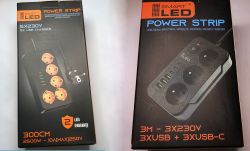I was just about to start the promised inverter tests, but this morning I got a long and eagerly awaited charger straight from China. Unfortunately, it's stronger than me and I have to check it out.
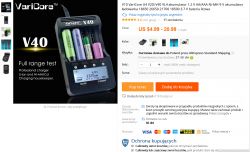
I ordered the "top version", the one for $ 20.99, the V40 model.
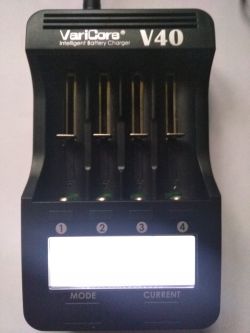
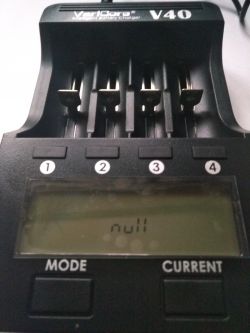
It is noteworthy that the set includes a 12V, 2A power supply in a very solid plug housing.

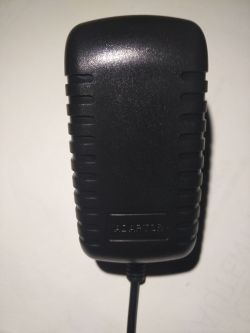
The charger is really universal and foolproof.
I will risk saying that it will charge up everything that fits.
As described in the auction, the charger has protection against reverse battery connection, short circuit protection (whatever that means) and protection against overcharging the battery (whatever that means). In the manual (interestingly - it is in the form of a hard booklet in two languages, of course Chinese and English), there is not a word about security features, so I will not check their effectiveness.
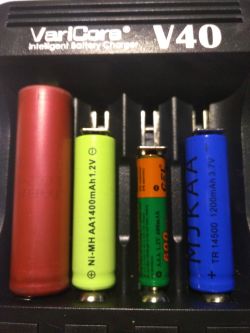
In the picture above, you can see some random links that I just had on hand when the photo was taken. And yes, the first from the left is 18650 of an unknown brand, once taken from a laptop battery and now from the flashlight that I carry on my belt. The second is an AA, Ni-MH link taken out of the mouse from the second computer, the brand of the link is also unknown. The third link is also Ni-MH, but this time AAA, which I got together with MaxCom walkie-talkies, and the last one is 14500 from friends from Aliexpress. Unfortunately, I did not have Ni-Cd, but the charger should also work without any problems.
As you can see in the pictures below - the charger "sees" a different link on each channel.
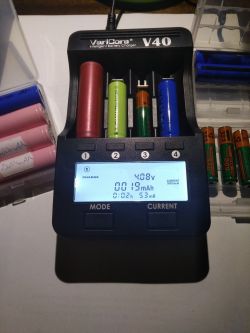
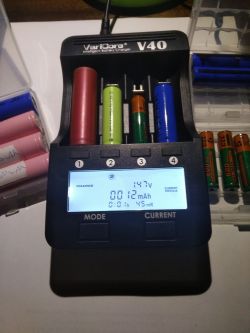

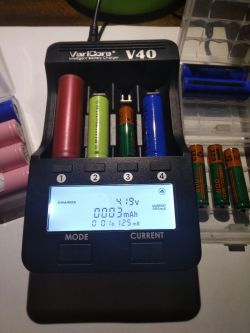
Now for some dry facts.
We have four independent channels at our disposal (there is also a separate USB 5V 1A output). We can insert a different type of battery into each connector and charge or discharge it.
On the backlit display, we have a number of very useful data, such as:
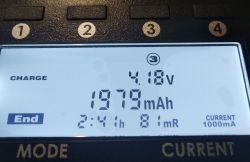
- channel number,
- operating mode,
- current voltage of a given cell,
- charging current of a given cell,
- time from the start of the measurement,
- the amount of currently "pumped" ampere-hours,
- and, perhaps most importantly, the internal resistance of the cells.
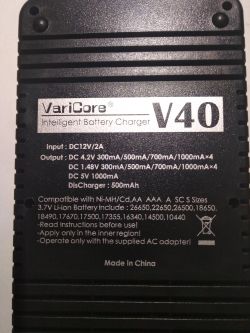
The charger has three basic functions:
Charger - Charging, we can choose (for each channel separately) charging current at the level of 300mA / 500mA / 700mA / 1000mA
Fast Test - Discharging. In this mode, the charger unloads the cells to a level that is safe for them. This is mainly to form Ni-MH cells. It also measures their capacity and remembers them on the display, but does not charge the batteries at the end of the test.
Nor Test - Discharge, capacity measurement and charge. In this mode, the charger discharges the batteries, remembers the result on the display, and then recharges the cells. This option is very useful when we leave the cells overnight for testing.
According to the specification, the charger supports the following types of cells:
26650, 22650, 26500, 18650, 18490, 18350, 17670, 17500, 17355, 16340, 14500, 10440, AAA, AA, A, SC, S.
A few more photos from the tests of 18650 cells:

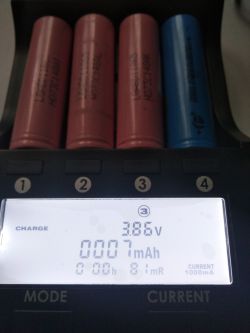

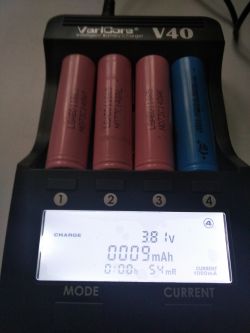
...
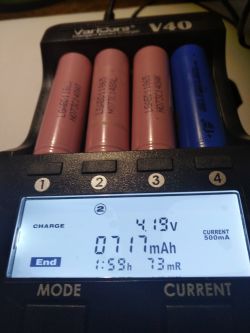
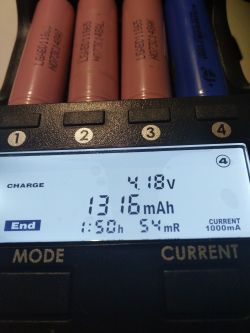
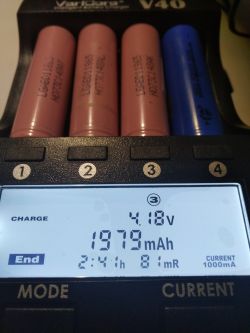

It is neither my first nor the only charger, but I feel that it will be my favorite charger, mainly due to the measurement of the internal resistance of the cells, which allows for the rejection of "low" cells almost immediately.
It's hard to speak after one day of testing. The charger managed to do two full "charge, discharge, charge" cycles for two 18650 battery packs, which is eight in total. It worked well, and the measurement results were very similar to those I performed recently on another device.
For such money, only take, charge and enjoy the purchase.
Ps. One user pointed out to me that I didn't mention an important point. Well, the 5V USB output uses the energy stored in the batteries and does not work when the charger is connected to the AC adapter. So it's basically a PowerBank feature.
"5V USB is only as a 3,7V lithium battery output, the output current is 1000mAh (nickel metal hydride battery is invalided).
5V USB is invalided when the charger is connected to the adapter.
If can be effectively output when the 3,7V lithium battery is put into any slot.
V40 USB 5V output is suitable for most of the mobile elecrtonic devices, but due to we did not test all products, do not exclude that some of the 5V electronic products are not applicable. "
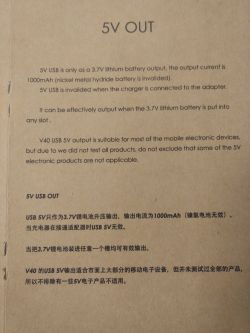
The same colleague accused me of incorrect information about the Nor Test mode.
Therefore, I am quoting a quote from the manual.
"Firstly, the charger charge the battery to be full electricity. Then to discharge the battery and record the elecrticity which is dispolayed on the LCD screen, until the battery is discharged (the end is twinkling, ant the real capacity is can be obtained) And then the charger the battery to be full electriciti again, but no to record. "
Let me translate this passage into ours.
First, the charger charges the cells to full capacity. Then it discharges the cells, measuring their capacity at the same time and, after the test is completed, saves it on the display. The charger then recharges the cells to full capacity, but saves nothing.
EDIT: February 20, 2018
Dueto the fact that the comments were overwhelming about the originality of this charger, as well as how to test the cell capacity, I allowed myself to do some additional tests and photos. You can clearly see that the charger measures the capacity when the batteries are discharged. You can also see that when charging quite old cells, the capacity measurement is sucked from the finger. Or maybe someone wants to buy a few years (maybe even ten years old) cell with a measured capacity of 4400mAh :)


FAST test and stored capacity measurement.
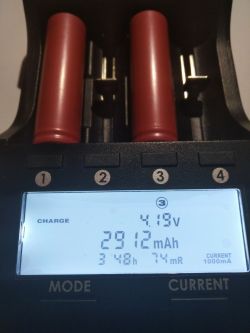

Landing. As you can see, after almost four hours, a lot more entered than we had just sucked out.
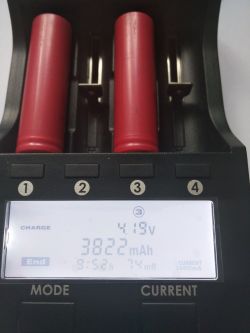
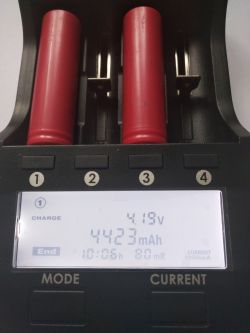
After about ten hours, charging is complete. The batteries were quite warm, but not above 45 ° C. As you can see, the capacity has magically more than doubled. A miracle or something .
.
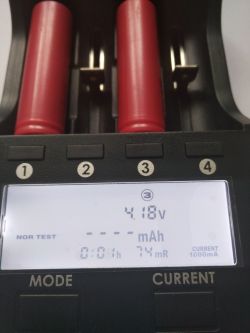
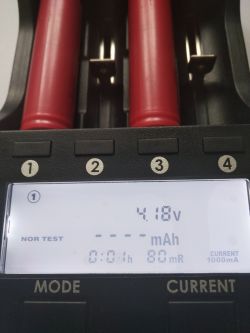
NOR Test, here we go.

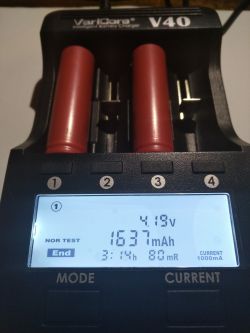
Test complete. Oh, and where are the rest of my Ampere hours? Could they turn into the heat generated by the cells during charging? The difference between fast test and normal test is due to my mistake. Fast was made at 500mA and normal at 1000mA.
Hope this will clear up your doubts. At least in terms of how to measure.
Best regards.
CMS.

I ordered the "top version", the one for $ 20.99, the V40 model.


It is noteworthy that the set includes a 12V, 2A power supply in a very solid plug housing.


The charger is really universal and foolproof.
I will risk saying that it will charge up everything that fits.
As described in the auction, the charger has protection against reverse battery connection, short circuit protection (whatever that means) and protection against overcharging the battery (whatever that means). In the manual (interestingly - it is in the form of a hard booklet in two languages, of course Chinese and English), there is not a word about security features, so I will not check their effectiveness.

In the picture above, you can see some random links that I just had on hand when the photo was taken. And yes, the first from the left is 18650 of an unknown brand, once taken from a laptop battery and now from the flashlight that I carry on my belt. The second is an AA, Ni-MH link taken out of the mouse from the second computer, the brand of the link is also unknown. The third link is also Ni-MH, but this time AAA, which I got together with MaxCom walkie-talkies, and the last one is 14500 from friends from Aliexpress. Unfortunately, I did not have Ni-Cd, but the charger should also work without any problems.
As you can see in the pictures below - the charger "sees" a different link on each channel.




Now for some dry facts.
We have four independent channels at our disposal (there is also a separate USB 5V 1A output). We can insert a different type of battery into each connector and charge or discharge it.
On the backlit display, we have a number of very useful data, such as:

- channel number,
- operating mode,
- current voltage of a given cell,
- charging current of a given cell,
- time from the start of the measurement,
- the amount of currently "pumped" ampere-hours,
- and, perhaps most importantly, the internal resistance of the cells.

The charger has three basic functions:
Charger - Charging, we can choose (for each channel separately) charging current at the level of 300mA / 500mA / 700mA / 1000mA
Fast Test - Discharging. In this mode, the charger unloads the cells to a level that is safe for them. This is mainly to form Ni-MH cells. It also measures their capacity and remembers them on the display, but does not charge the batteries at the end of the test.
Nor Test - Discharge, capacity measurement and charge. In this mode, the charger discharges the batteries, remembers the result on the display, and then recharges the cells. This option is very useful when we leave the cells overnight for testing.
According to the specification, the charger supports the following types of cells:
26650, 22650, 26500, 18650, 18490, 18350, 17670, 17500, 17355, 16340, 14500, 10440, AAA, AA, A, SC, S.
A few more photos from the tests of 18650 cells:




...




It is neither my first nor the only charger, but I feel that it will be my favorite charger, mainly due to the measurement of the internal resistance of the cells, which allows for the rejection of "low" cells almost immediately.
It's hard to speak after one day of testing. The charger managed to do two full "charge, discharge, charge" cycles for two 18650 battery packs, which is eight in total. It worked well, and the measurement results were very similar to those I performed recently on another device.
For such money, only take, charge and enjoy the purchase.
Ps. One user pointed out to me that I didn't mention an important point. Well, the 5V USB output uses the energy stored in the batteries and does not work when the charger is connected to the AC adapter. So it's basically a PowerBank feature.
"5V USB is only as a 3,7V lithium battery output, the output current is 1000mAh (nickel metal hydride battery is invalided).
5V USB is invalided when the charger is connected to the adapter.
If can be effectively output when the 3,7V lithium battery is put into any slot.
V40 USB 5V output is suitable for most of the mobile elecrtonic devices, but due to we did not test all products, do not exclude that some of the 5V electronic products are not applicable. "

The same colleague accused me of incorrect information about the Nor Test mode.
Therefore, I am quoting a quote from the manual.
"Firstly, the charger charge the battery to be full electricity. Then to discharge the battery and record the elecrticity which is dispolayed on the LCD screen, until the battery is discharged (the end is twinkling, ant the real capacity is can be obtained) And then the charger the battery to be full electriciti again, but no to record. "
Let me translate this passage into ours.
First, the charger charges the cells to full capacity. Then it discharges the cells, measuring their capacity at the same time and, after the test is completed, saves it on the display. The charger then recharges the cells to full capacity, but saves nothing.
EDIT: February 20, 2018
Dueto the fact that the comments were overwhelming about the originality of this charger, as well as how to test the cell capacity, I allowed myself to do some additional tests and photos. You can clearly see that the charger measures the capacity when the batteries are discharged. You can also see that when charging quite old cells, the capacity measurement is sucked from the finger. Or maybe someone wants to buy a few years (maybe even ten years old) cell with a measured capacity of 4400mAh :)


FAST test and stored capacity measurement.


Landing. As you can see, after almost four hours, a lot more entered than we had just sucked out.


After about ten hours, charging is complete. The batteries were quite warm, but not above 45 ° C. As you can see, the capacity has magically more than doubled. A miracle or something


NOR Test, here we go.


Test complete. Oh, and where are the rest of my Ampere hours? Could they turn into the heat generated by the cells during charging? The difference between fast test and normal test is due to my mistake. Fast was made at 500mA and normal at 1000mA.
Hope this will clear up your doubts. At least in terms of how to measure.
Best regards.
CMS.
Cool? Ranking DIY



